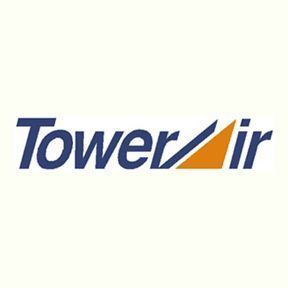FF TOW Destinations 9 Motto "Going Places" Ceased operations 2000 | TOW Tee Air Company slogan "Going Places" Founded 1983 Fleet size 17 | |
 | ||
Key people Morris K. Nachtomi (co-founder, owner, manager) Focus cities Ben Gurion International Airport | ||
going places tribute to tower air
Tower Air was a certificated FAR 121 schedule and charter U.S. airline that operated from 1983 until 2000, when the company declared bankruptcy and was liquidated. Scheduled flights were initially offered over a New York – Brussels – Tel Aviv route in addition to charter flights to Athens, Frankfurt, Rome, and Zurich. Short-lived New York – Los Angeles flights were introduced with the addition of an ex-Avianca Boeing 747-100 in 1984. The airline was headquartered in Building 178 and later in Hangar 17 at John F. Kennedy International Airport in Jamaica, Queens, New York City.
Contents
- going places tribute to tower air
- History
- Destinations at time of closure
- Destinations before closure
- Aircraft
- Incidents and accidents
- References
History
Tower Air was co-founded, majority owned, and managed by Morris K. Nachtomi, an Israeli citizen who had emigrated to the United States. After a 30-year career with El Al, Nachtomi joined a wholesaler and tour package operator Tower Travel Corporation in 1981. Tower Travel Corporation was founded by Zev Melamid and his wife Estelle in the 1970s to promote discount travel to Israel. Tower Travel Corporation is credited with developing the wholesale charter market between New York and Tel Aviv.
Tower Air was formed on August 13, 1982 by Zev Melamid, Mordechi Gill, Morris Nachtomi, and Sam Fondlier as equal shareholders. The airline was formed to replace the lift Tower Travel Corporation lost when Flying Tiger Line via a subsidiary, Metro International Airlines, decided to end scheduled and charter commercial passenger service (although military airlift cargo flights operated by Flying Tiger continued) and the three Boeing 747s configured for passenger flights were traded to Pan Am in exchange for all-cargo 747 freighter aircraft.
Arthur Fondlier, son of Sam Fondlier and the former Chief Financial Officer of Tower Air, was a passenger in first class section of Pan Am flight 103. His untimely death gave Morris Nachtomi much more freedom in management and cost-cutting.
The company won many contracts from the United States Department of Defense to transport armed forces personnel to overseas locations, and from the United Nations to transport troops to their peacekeeping missions all over the world. Tower often flew charters for groups of Muslim pilgrims to Mecca.
Tower Air's main base of scheduled operations was John F. Kennedy International Airport in Jamaica, New York and during their peak they had their own terminal (a former Pan Am Admin facility). There was a large focus on flights to Ben Gurion International Airport in Tel Aviv, Israel, becoming a major competitor to El Al and British Airways in the US-Israel market. The airline also had several flights to France, Greece and Brazil, as well as high density domestic destinations in the New York market, including San Juan, Miami, Los Angeles, and Las Vegas, Nevada. Tower Air also sometimes provided substitute aircraft for other carriers, for example on the JFK to LHR route when weather delayed an inbound Virgin Atlantic Airways flight in December 1994.
The 1997 Zagat Survey ranked Tower Air 59th out of 61 ranked carriers in terms of maintenance, ahead of only Valujet and Aeroflot. In February 1998, the Federal Aviation Administration proposed two civil penalties totaling $276,000 for continuing to fly aircraft that required maintenance. In January, 1998 the FAA successfully sought to have the airline remove Guy Nachtomi, son of the Chairman and CEO, 24 years old at that time, from the position of Vice President-Operations. This was done in part because of the airline's maintenance problems, as well as his lack of airline experience (he worked at Twentieth Century Fox until 1994). The junior Mr. Nachtomi continued service with the company in a capacity unrelated to maintenance as Vice President-Office of the Chairman. The Department of Defense Commercial Airlift Review Board suspended Tower Air military charters from January 27 to February 12, 1999, pending an on-site review of its operations. At the same time the airline lost an arbitration brought by the Association of Flight Attendants, claiming that Tower Air was lodging their flight attendants in dirty Tel Aviv hotels with poor security and bed bugs.
Tower Air filed for protection under Chapter 11 bankruptcy on February 29, 2000, ceased all scheduled service on May 1, 2000 and surrendered their FAA air operator's certificate on November 28, 2000.
Destinations at time of closure
Destinations before closure
Aircraft
Tower Air's fleet consisted of Boeing 747s in both the −100 and −200 series, including both passenger and cargo aircraft.
Incidents and accidents
On December 20, 1995, Tower Air flight 41 from New York Kennedy to Miami veered off the runway during takeoff in a snowstorm resulting in one flight attendant receiving serious injuries and 24 passengers receiving minor injuries. The aircraft sustained heavy damage and had to be written off. The National Transportation Safety Board (NTSB) determined that the probable cause of this accident was the captain's failure to reject the takeoff in a timely manner when excessive nosewheel steering tiller inputs resulted in a loss of directional control on a slippery runway.
